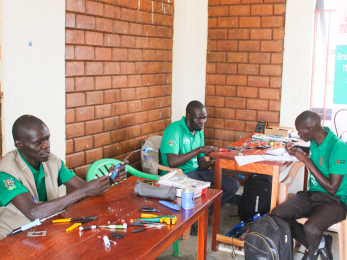Market Impacts of COVID on Northeast Nigeria

COVID‑19 was first detected in Nigeria on February 29, 2020, and case numbers rose steadily through the spring and early summer, beginning to plateau and then decline in July and August. As of August 27, 2020, 53,021 cases have been confirmed in Nigeria, with 740 cases in Borno, 719 in Gombe, 217 in Adamawa, and 67 in Yobe.
COVID‑19 presents multiple concerns for households in northeast Nigeria still facing or recovering from the insecurity of the Boko Haram conflict. Numerous challenges in poor infrastructure, security and access, and a decimated health care system hamper both case identification and treatment, and although testing capacity improved nationally, it is unlikely to know and understand the full count of infections in the Northeast. Borno State in particular lost roughly 40% of its healthcare facilities in the conflict, with hundreds of health care workers killed or injured and skilled physicians fleeing to other states.
The rapid assessment was conducted to facilitate the USAID Feed the Future Rural Resilience Activity’s (RRA) startup in this unpredictable context by providing insight into market impacts and critical constraints facing households and actors in the Northeast. COVID‑19 is a novel threat, which has prompted restrictions in movement and shipping throughout the country and world, and its effects in the region may not follow the pattern of previous shocks. This assessment examined the impacts on private firms within value chains, groups that fill supporting functions and affect rules and norms such as the government and financial institutions, and households engaged in market activities. Understanding each group’s experience of COVID‑19, their responses, and their needs are intended to contribute to responses by RRA and other development actors.
Framework
This assessment draws on Mercy Corps’ market systems resilience (MSR) measurement framework, adapted from USAID’s MSR measurement framework, to categorise market actors and organise the analysis. For the purpose of this assessment, the framework describes shock impacts, responses, and functionality among the different levels of actors. Over time, the framework can also be used to examine the dynamic resilience of these levels and to understand how the resilience of one group interacts with another.
COVID‑19 impacts on livelihoods, and employment
Awareness of movement restrictions: Households in the Northeast were universally aware of government restrictions due to COVID‑19, with 97% of respondents aware of the restrictions in Yobe and 100% in the other three states. This aligns with the relative newness of the movement restrictions there, averaging 3.1 weeks before the survey, compared to 4 – 5 weeks in the other states.
Income, expenditure, and debt
COVID‑19 and associated restrictions substantially impacted households’ ability to work, earnings, and expenditure. Many households expected some return to normalcy within the next month but had also seen large decreases in their income and expenditure during the previous month. On average, weekly household income had decreased 55% from 10,850 naira to 4,970 naira, while weekly expenditures had decreased 22% from 7,400 to 5,700 naira. Average household debt also increased by 26%, from 18,200 naira before COVID‑19 to 22,900 at the time of the survey.
Changes in work and employment
This loss of income stems from a decrease in livelihood and work opportunities: 70% of households engaged in farm work, averaging 3.5 members conducting farm activities full- or part-time before the pandemic, reduced to 1.7 at the time of the survey. Off-farm labour experienced a similar reduction, from three household members before COVID‑19 to 0.9 at the time of the survey.


